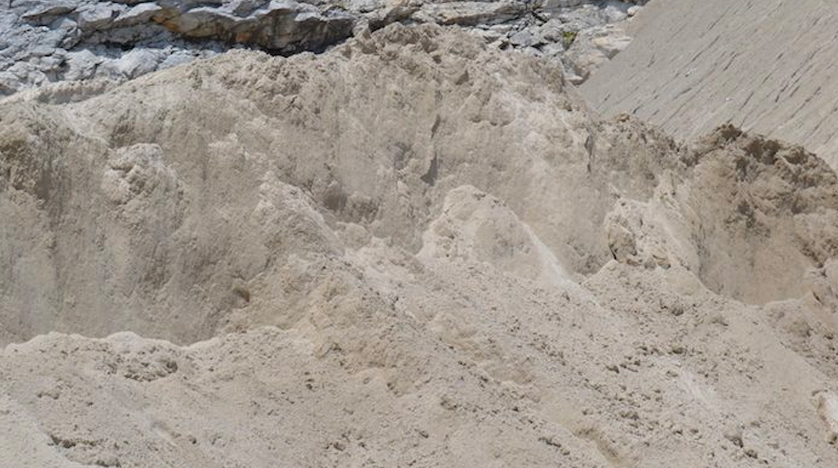
Posted September 16, 2016
Category(s) Industry News Materials

Healthy crops and vegetation begin with healthy soil. This is a fundamental truth that anyone with a green thumb can tell you.
No matter how hard you work to protect your soil, though, you can count on the fact that, over time, its nutrient supply will begin to deplete and its pH levels will begin to change. Both of these occurrences can create less-than ideal growing conditions.
This doesn’t mean you have to dig up all of your old soil and replace it with new stuff, though. The simplest and most affordable way to correct common problems associated with frequently used soil is to introduce agricultural lime (or aglime, for short).
But while aglime is highly effective and frequently used throughout NJ, we’ve found that many people don’t really know that much about it. To clear the air, we’ve dedicated this post to providing answers to 10 of the most frequently asked questions about aglime.
First of all, what is aglime anyway? Agricultural lime is made up of limestone that has been pulverized and crushed down to an extremely small particle size.
Once reduced to this size, the particles are able to be tilled into any soil that’s in poor health in order to raise the soil’s pH levels for ideal growing conditions, to supply the soil with important minerals like calcium and magnesium, to encourage soil microbe activity and to improve a plant’s root system’s ability to absorb nutrients.
One of the first signs that you might benefit from the use of agricultural lime is a crop that appears less healthy or vibrant than in other growing seasons. The only way to know, without a doubt, however, is to have your soil’s pH levels tested.
You’ll then need to compare the pH of your existing soil against the required pH levels for growing the specific type or types of crops that you’re planning to grow there. This will tell you whether or not you need to add a liming agent in order to restore balance to the soil’s pH.
When lime is pulverized into extremely fine pieces, its alkaline properties have the ability to actually raise the pH of soil that has grown overly acidic throughout the years. This is important because specific pH levels must exist in order for specific plants to grow and thrive.
The pH level of your soil can impact the way in which it absorbs moisture, the amount of microbe activity it enjoys, the minerals and nutrients available and can even affect the uptake of nutrients through a plant’s root system.
For starters, it’s important to know that the smaller your aglime particles are, the more effective it will be. Next, know that agricultural lime tends to be most effective when it is tilled into the soil.
Finally, be aware that agricultural lime won’t activate unless it’s exposed to water, so when spreading dry lime, you’ll need to also spray water evenly and deliberately across the soil that’s being treated.
The primary difference between these two liming materials is the type of limestone from which they are derived. As the name suggests, calcitic lime tends to have higher levels of calcium.
Dolomitic lime, on the other hand, features high volumes of magnesium. Both are very effective in restoring balance to acidic soil.
Unless your soil is unusually deprived of the mineral magnesium, though, it isn’t usually necessary to specifically seek out dolomitic lime. Calcitic lime will do the trick, is very easy to find in your locale and is extremely affordable.
Liquid lime is a carefully formulated blend of both dry lime and water that can be sprayed directly across the surface of your soil. It’s much easier to control the even distribution of liming materials, but be aware of the fact that liquid lime tends to be more expensive and generally will need to be applied more often.
Those who have soil with pH levels that are extremely low (acidic) and in very poor health may begin to notice positive results within several weeks. For the most part, though, you should expect that you won’t realize the full effect of what agricultural lime can do for at least a year, or one growing season.
Yes. While agricultural lime is most frequently used for larger commercial growing operations, many homeowners have found that its use on residential lawns can help to create more hospitable growing conditions for grass, freshly laid sod or vegetable gardens.
Be sure to talk with a trusted professional about the best type of lime for your lawn and how much of it should be used to restore pH levels to balance.
Different people experience different rates at which their soil becomes overly acidic and needs to be treated with agricultural lime.
Areas that are prone to high volumes of acidic rain or fields that are frequently treated with certain types of acidic fertilizers and pesticides, for example, may demand more frequent treatments of aglime.
Keep an eye on the virility of your crops and be vigilant about having your soil’s pH levels tested in order to know, for sure, when you should re-apply aglime.
The cost of agricultural lime can vary based upon several factors. First, you’ll need to consider the type of aglime that you’re planning on using.
Liquid lime, for example, tends to be slightly more expensive than dry lime. Secondly, you’ll need to think about the source.
Was the liming agent produced locally, or is it coming from a remote location? If the materials must be shipped and transported across the country, you should plan on spending more money.
It’s for this reason that we encourage our customers to buy their agricultural lime locally. Of course, it’s always important to evaluate the quality of the liming materials prior to purchase. Just because lime is very cheap doesn’t mean that you’re getting a good deal.
Remember that the smaller the aglime is, the faster acting it will be. Knowing what to look for from your lime will help you get the best price for your materials.
Residents of NJ and its surrounding areas know that they can count on Braen Stone to handle all of their liming needs. We own and operate quarries throughout the state.
Here, we take pride in harvesting the highest quality lime and then carefully pulverizing and screening the lime down to the ideal particle sizes for improving soil health. Because we manufacture our agricultural lime on our own, we’re able to maintain control over both quality and pricing.
Our customers get the lowest, wholesale prices on our materials. Our aglime can be picked up or bulk delivered to locations throughout parts of NJ, NY, NYC and PA.
VIBRATION CONCERNS SUPPORT NUMBER
973-720-7094
Thank you! Your form was submitted successfully.
There has been an error submitting your form.